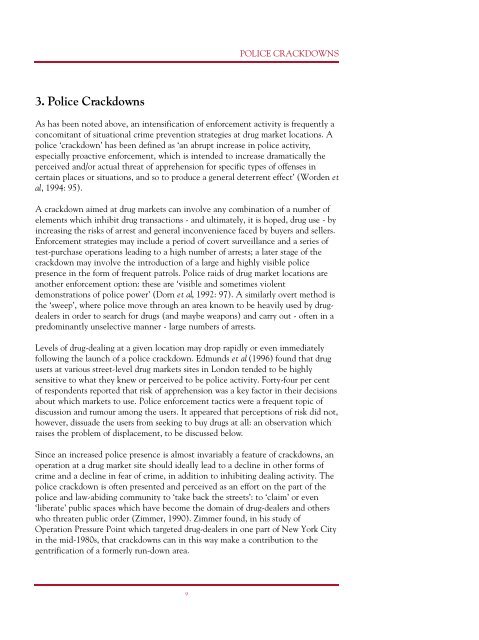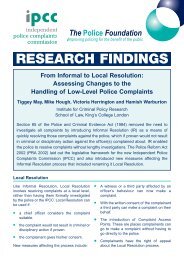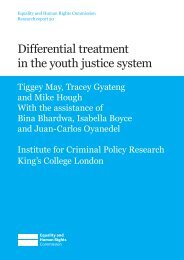Policing Drug Hot-Spots - Center for Problem-Oriented Policing
Policing Drug Hot-Spots - Center for Problem-Oriented Policing
Policing Drug Hot-Spots - Center for Problem-Oriented Policing
You also want an ePaper? Increase the reach of your titles
YUMPU automatically turns print PDFs into web optimized ePapers that Google loves.
POLICE CRACKDOWNS3. Police CrackdownsAs has been noted above, an intensification of en<strong>for</strong>cement activity is frequently aconcomitant of situational crime prevention strategies at drug market locations. Apolice ‘crackdown’ has been defined as ‘an abrupt increase in police activity,especially proactive en<strong>for</strong>cement, which is intended to increase dramatically theperceived and/or actual threat of apprehension <strong>for</strong> specific types of offenses incertain places or situations, and so to produce a general deterrent effect’ (Worden etal, 1994: 95).A crackdown aimed at drug markets can involve any combination of a number ofelements which inhibit drug transactions - and ultimately, it is hoped, drug use - byincreasing the risks of arrest and general inconvenience faced by buyers and sellers.En<strong>for</strong>cement strategies may include a period of covert surveillance and a series oftest-purchase operations leading to a high number of arrests; a later stage of thecrackdown may involve the introduction of a large and highly visible policepresence in the <strong>for</strong>m of frequent patrols. Police raids of drug market locations areanother en<strong>for</strong>cement option: these are ‘visible and sometimes violentdemonstrations of police power’ (Dorn et al, 1992: 97). A similarly overt method isthe ‘sweep’, where police move through an area known to be heavily used by drugdealersin order to search <strong>for</strong> drugs (and maybe weapons) and carry out - often in apredominantly unselective manner - large numbers of arrests.Levels of drug-dealing at a given location may drop rapidly or even immediatelyfollowing the launch of a police crackdown. Edmunds et al (1996) found that drugusers at various street-level drug markets sites in London tended to be highlysensitive to what they knew or perceived to be police activity. Forty-four per centof respondents reported that risk of apprehension was a key factor in their decisionsabout which markets to use. Police en<strong>for</strong>cement tactics were a frequent topic ofdiscussion and rumour among the users. It appeared that perceptions of risk did not,however, dissuade the users from seeking to buy drugs at all: an observation whichraises the problem of displacement, to be discussed below.Since an increased police presence is almost invariably a feature of crackdowns, anoperation at a drug market site should ideally lead to a decline in other <strong>for</strong>ms ofcrime and a decline in fear of crime, in addition to inhibiting dealing activity. Thepolice crackdown is often presented and perceived as an ef<strong>for</strong>t on the part of thepolice and law-abiding community to ‘take back the streets’: to ‘claim’ or even‘liberate’ public spaces which have become the domain of drug-dealers and otherswho threaten public order (Zimmer, 1990). Zimmer found, in his study ofOperation Pressure Point which targeted drug-dealers in one part of New York Cityin the mid-1980s, that crackdowns can in this way make a contribution to thegentrification of a <strong>for</strong>merly run-down area.9






